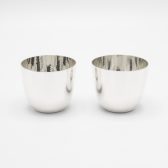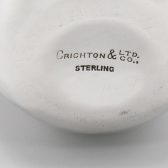
Pair of American Sterling Silver Tumbler Cups
Originating in the 17th century, sterling silver tumbler cups were designed with a rounded base, which was designed to be thicker than the sides. When the tumblers were placed on the table, they would ‘tumble’ around, due to the rounded bottom. It was suggested that this was in order to sell more alcohol, as the drinker was not able to put the tumbler down until they had finished their drink.
This curved and heavier base allows the cup to rock without spilling, a functionality that was particularly useful when travelling. The rounded base of a tumbler meant that during a journey in a coach or (later) train, the cup would maintain its balance.
A handsome pair of American Sterling Silver Tumbler Cups that are quite elegant and simple in design. The simplicity of the body of these silver Tumbler Cups makes them a perfect candidate for engraving. They are made by Crichton and Company, who was the US trading name for the English silversmithing firm, Crichton Brothers.
In today’s society, most people prefer using Tumbler Cups for cold drinks like lemonade, iced teas, smoothies, and summer cocktails.






